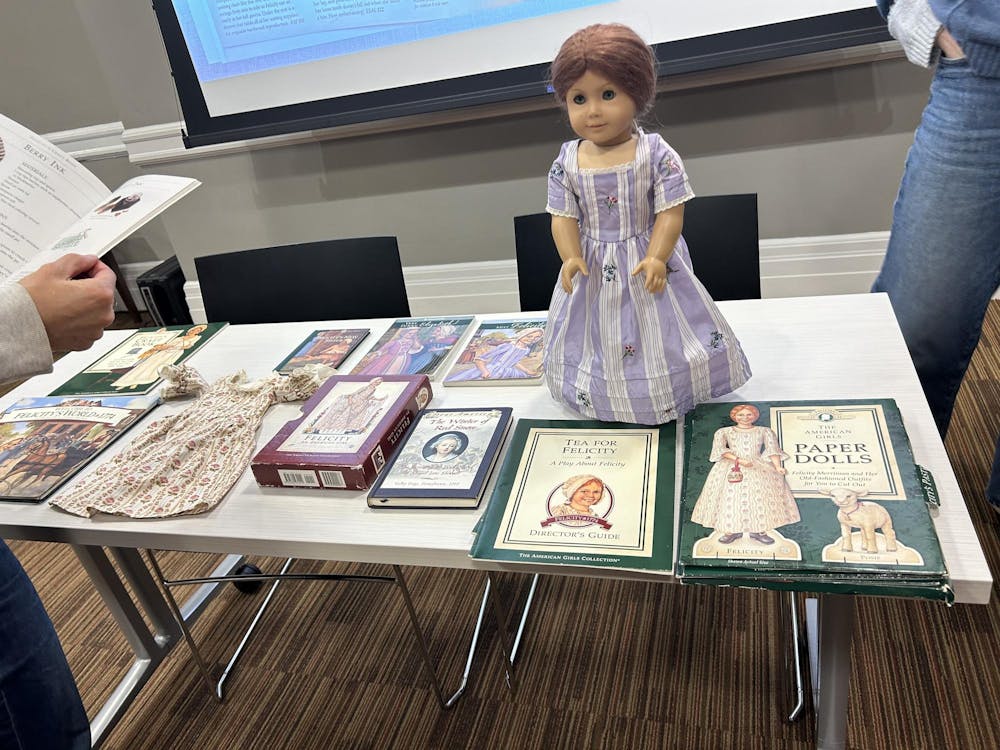At just 18 inches tall, Felicity Merriman has a defiant look in her plastic eyes, a determined set to her painted mouth and a commanding presence in any room.
Although Felicity was positioned at center stage, the real star of the show on Monday was Allison Horrocks, a historian and co-creator of the podcast “Dolls of Our Lives.”
Since 2018, Horrocks, along with her co-creator Mary Mahoney, has been using her PhD in history to revisit the American Girl doll books, widely read by young girls in the United States.
The podcast, which has over a million downloads, has inspired meetups and internet groups to bond over listeners’ shared love of the world of American Girl.
Horrocks spoke on Monday night in the Petteruti Lounge. Her talk was part of a series of events hosted by the University celebrating the semiquincentennial — the 250th anniversary — of the signing of the Declaration of Independence, which will occur in 2026.
Each American Girl Doll is both a toy and a character. The physical dolls are created along with a series of books, mostly written by author Valerie Tripp along with other co-writers and historical consultants, which tell the story of the characters’ coming of age in a particular historical period. The company was created in the 1990s by Pleasant Rowland, who wanted the dolls to connect young girls with American history in a way that was relatable and age- appropriate.
Horrocks’ talk focused on the doll Felicity Merriman, a fictional 9-year-old girl whose story is set in Colonial Williamsburg, Virginia between 1774 and 1776.
“In these six books, Felicity does a number of things,” Horrocks summarized. “She frees an abused horse. She weathers a friendship drama over loyalism. She attends a governor’s ball, aborts a gunpowder plot, assists a runaway apprentice and deals with the loss of her beloved grandfather. All of this is set against the backdrop of the (American) Revolution, which is at first a minor and then a major part of the story.”
“Part of the complexity of Felicity is that she’s a product of the ’90s as much as the 18th century,” said Horrocks. The books represent a second-wave feminist perspective, and have received some criticism because although they feature enslaved people, Felicity does not engage with questions of the morality of slavery.
While the series heavily foregrounds themes concerning freedom and independence, Felicity’s grandfather owns a plantation staffed by enslaved people, which her mother later inherits.
“Felicity never experiences moral qualms about indenture or enslavement,” Horrocks said. Instead, freedom for Felicity is about freedom from Great Britain and her ability “to wear pants and free a horse that she loves.”
American Girl Doll as a brand, however, does engage with the history of slavery in its series on Addy Walker, a Civil War era character who escapes from enslavement.
Horrocks explained that the American Girl Doll books are not a textbook and do not seek to be a comprehensive history of the American Revolution. Instead, they seek to allow young readers to feel a connection to historical moments. As a child, Felicity “allowed me to think about things that were important to me … and to imagine what it would feel like to experience that in a very different context,” Horrocks reflected.
“When people talk about children’s literature, its impact can be felt through characters as mirrors and windows,” she said.
For many, Felicity was both a window into another time and a reflection of the types of issues that resonate with many children.
“The essential truth that the brand tried to communicate is that it’s hard when you and your friend disagree. It’s hard when you don’t have the outfit you want. These are realities that people can use as a wedge” to better connect with and understand history, elaborated Horrocks.
The American Girl Doll brand played a large role in creating an early interest in history for many little girls.
“I felt that Felicity was a critical player in my early life because she gave me an edge. When I was in elementary school, I knew key events about non-New England revolutionary history because Felicity taught them to me,” said Horrocks. “Felicity experienced these things, and she brought them into my life and expanded my basis for what the revolution could look like.”
American Girl Doll remains influential in the lives of many children today and has broadened its approach to history over time, adding dolls with different racial and religious backgrounds to its collection, and centering historical moments like the Harlem Renaissance of the 1920s and the Civil Rights Movement of the 1960s.
Recently, American Girl added a set of twin dolls celebrating the year 2000. For many, this was jarring, but for Horrocks “it was shocking and it was fun … If it has already happened, it’s history, and to allow people who’ve had a wide range of experiences to see history as theirs to own, to understand and to make is an enduring quality of American Girl that I love.”
Correction: A previous version of this article incorrectly stated that the event was hosted by the history department.

Kate Butts is a senior staff writer covering University Hall. Outside of The Herald, she loves running, board games and Trader Joe's snacks.





